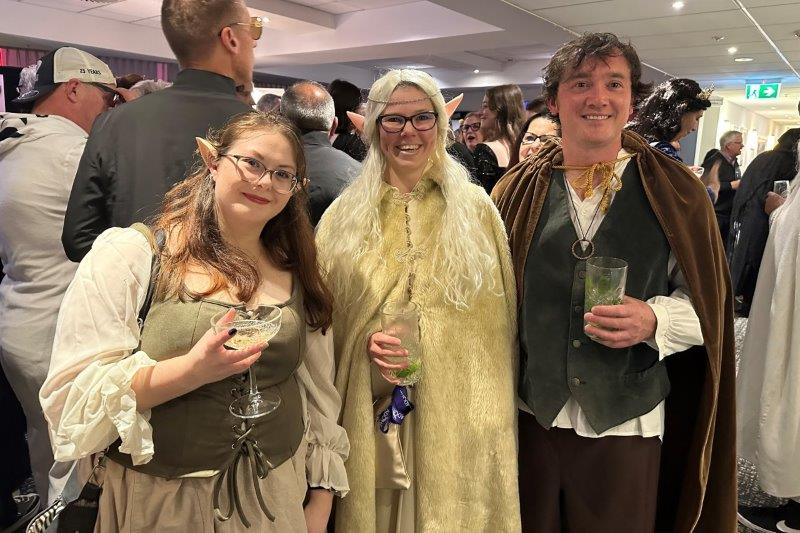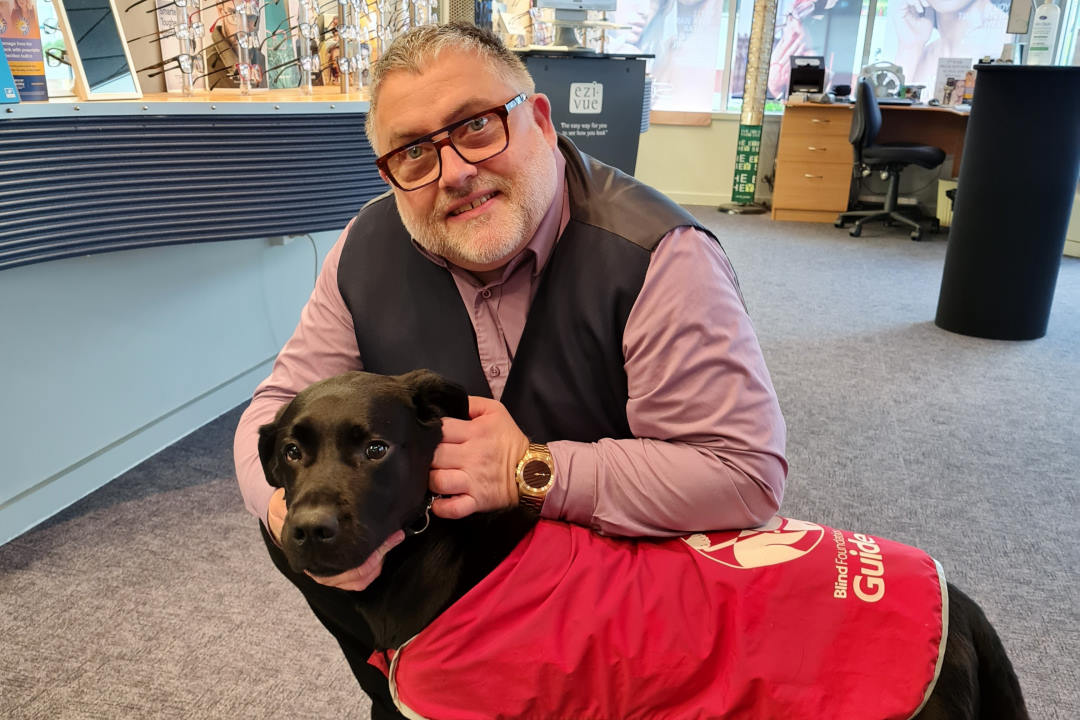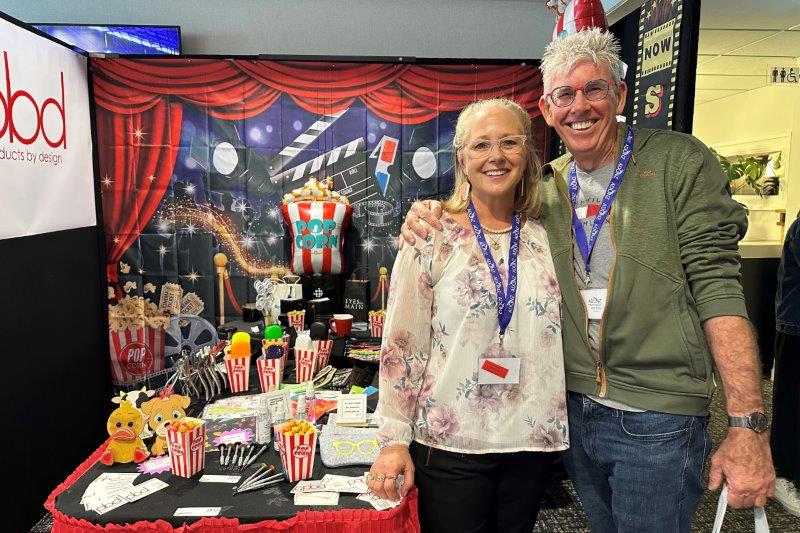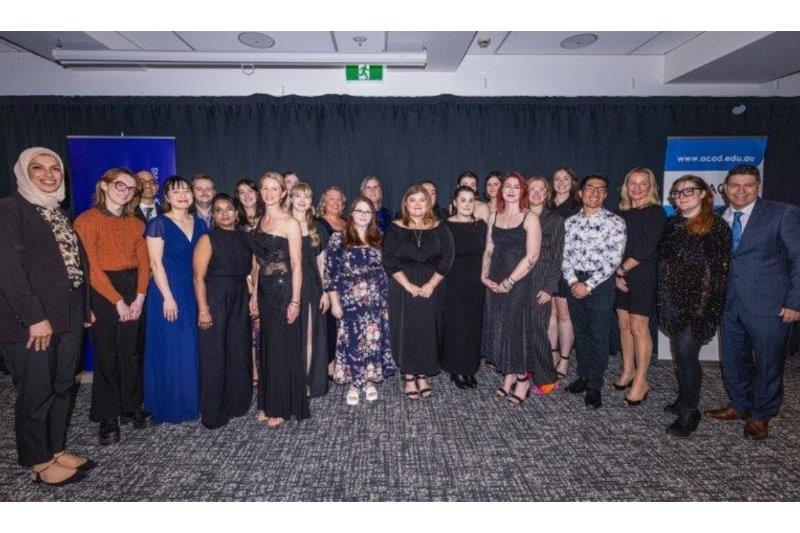Seeing clearly: Wellywood dispensing advancement and fun
The Association of Dispensing Opticians New Zealand (ADONZ) annual conference in Wellington was a whirlwind of fascinating learning, stimulating conversations, gala and glam. Although it felt like the weekend was over in a flash, I’m certain it left delegates armed with fresh knowledge to incorporate into their practice. Despite this year’s shorter two-day format, organisers still packed a punch, with plenty of education and time to peruse the busy trade floor.
Looking to the future, the educational programme kicked off with a talk on scope expansion. Dr Phil Turnbull, senior lecturer at the School of Optometry and Vision Science, University of Auckland and advisor to the Optometry and Dispensing Opticians Board, shared survey data revealing most DOs are keen to upskill and expand the profession’s scope. Discussing how to do this safely, he delved into existing ways of practising at the limit of the current scope, including delegated tasks. Delegated tasks are done under supervision (the responsibility ultimately lies with the delegator) and include performing visual field exams, OCT scans and taking medical history. In a practice, there’s also the opportunity to have a standing order allowing a DO to administer eye drops for dilation. Ultimately, Dr Turnbull said any scope expansion should be guided by what’s best for the public, drives better health outcomes and makes best use of skills.
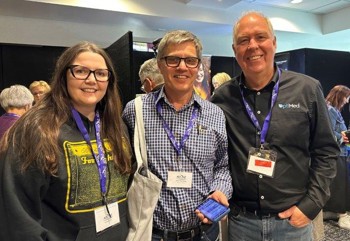
Lucie Grant, Steve Stenersen and Optimed’s Robert Nyenkamp
The modern patient – symptoms and solutions
Zooming in from Sydney, Alcon’s professional education and development manager Joshua Clark covered digital eye strain (DES) and the relationship between vision quality and visual comfort. DES is primarily caused by a reduced blink rate (we blink 60% less during screen viewing) but uncorrected astigmatism as little as 0.50 to 1.00D can also increase symptoms, he said. For contact lens (CL) wearers using digital devices, he advised eyecare practitioners to make the following considerations: optimise the ocular surface prior to CL wear, check for signs and symptoms of dry eye and manage underlying meibomian gland dysfunction, blepharitis and demodex; select a comfortable CL with high lubricity (how slippery it is); correct low amounts of astigmatism to minimise blur and visual disturbance and manage underlying binocular vision anomalies; and, finally, consider modifications to the environment, including humidity levels and air conditioning.
Another modern-day concern associated with screen time is the childhood myopia epidemic, estimated to affect more than 50% of the world’s population by 2050. Luckily, there are plenty of effective tools to manage myopia, said Eleisha Dudson, an optometrist who specialises in myopia management and CL fitting at Wellington practice McClellan Grimmer Edgar. Most practices will dispense myopia management solutions such as myopia control spectacle lenses, soft CLs and ortho-k, which have a similar myopia-reducing effect of about 50–60% with little to no rebound effect, she said. Adding low dose atropine (0.05% or 0.025%) to the treatment can help control dioptre and axial length (AL) growth further, if required. For patients with faster progression, repeated low-level red light therapy can achieve significant results (76.6% refraction and 69.4% control in AL growth), almost akin to 1% atropine without the side effects, Dudson said. “Overall, the most effective solution is the one the child will use,” she said, adding DOs can play an important role to educate and motivate the child by explaining how the solution will help their vision and that it’s more effective the more it’s used. This is key, as well as encouraging them to spend two hours per day outdoors, she concluded.

Christine Doorman with Titan Optical’s Rose Rogers
Lifestyle was also considered in UK-based Eluned Creighton-Sims’ entertaining talk on the modern patient. Having spent decades in dispensing and lab roles, Creighton-Sims, now education and professional development manager with IOT Lenses, said knowledge about a patient’s lifestyle and habits is essential for successful dispensing. Using a complex-needs case study, she illustrated how effective communication techniques, including rapport building, asking questions (rather than interrogating), building on questions and confirming your understanding will help identify wearers’ needs. Asking tricky patients to video their desk setup and other requirements can be really helpful too, she said.
Understanding consumer rights
Wrapping up day one with an ethical perspective, Randal Southee and Charmaine Pene from the Nationwide Health & Disability Advocacy Service gave a thought-provoking talk on consumer rights in the health space. The Code of Health and Disability Services Consumers’ Rights includes a patient’s right to be treated with respect and fairness, to be told everything they need to know in a way they understand and the right to make their own choices about their care. Southee and Pene challenged the audience, asking if these rights were always considered in practice. For example, when assessing a patient’s needs, are there other factors influencing the solution offered – like sales targets? Ultimately, they said, if a client is experiencing difficulty with your service, think resolution. Consider what steps you can take to resolve the concern to the satisfaction of the consumer. Avoiding an official complaint is crucial as it would put your professional life on hold for an extended period of time, they said.
Good ways of welcoming and incorporating customer feedback, for example through a post-visit survey accessible via a QR code, were also discussed. For more information for providers, including how to order consumer advocacy leaflets, see https://advocacy.org.nz/.

ODOB chair Kristine Hammond winning at
EssilorLuxottica’s popular arcade game
Falls and dementia
First up on Saturday morning was optometrist Renee Edgar, also from McClellan Grimmer Edgar, who has a special interest in neuro-optometric rehabilitation post-concussion. Perhaps surprisingly, sports only account for about 20% of all concussions, with falls being the predominant cause (about 30%). Visual issues, including double vision, headaches, photophobia and vestibular dysfunction (affecting balance and spatial orientation) are common post-concussion, but with appropriate management these patients can recover fully, Edgar said.
Interventions for rehabilitation of persistent visual symptoms following concussion include passive and active therapy, she explained. While the passive therapy seeks to preserve energy and help make vision efficient (spectacle lenses – avoid progressives during recovery – prisms, tints and occlusion), the active therapy seeks to enhance accommodation and convergence skills.

Costume-winning bees: Joanna Murray, Vicki Beames and Taryn Brown
Lyneta Russell from Alzheimers New Zealand spoke about the rapidly growing incidence of dementia and modifiable risk factors, which include vision loss and hypertension. The Prevalence of Visual Impairment in People with Dementia (PROVIDE) study (UK) on 708 adults living with dementia showed that 1 in 3 had visual impairment, of which 91% was potentially treatable. With reduced depth perception and contrast vision comes increased risk of falls, begging the question of whether the vision loss or the dementia is to blame, Russell said.
In a clinical setting, communication should be directed to the patient suffering from dementia, not the support person, in a patient and considerate manner. Russell recommended using the four S’s communication model: slow, simple, specific and show (demonstrate). Environmental factors a practice can consider making it more dementia friendly include clearly marking the entrance, exit and front desk; limiting background noise/proximity to another booth; good lighting; and limiting the number of staff involved in a visit. Keep written material short, simple and free from jargon and abbreviations. She also recommended using a clear font, size 12–14, with no italics or superfluous images.
For practices wishing to hand out a pocket-sized eyecare resource for people living with dementia, Dr Marianne Coleman, University of Melbourne, has created a handy guide (scan the QR code to download), shared by Russell.

Cataracts and the very young
After lunch, paediatric ophthalmologist Dr Cam Loveridge-Easther delved into paediatric aphakia due to congenital or traumatic cataracts. Paediatric aphakia is uncommon but not rare, accounting for 5–20% of childhood blindness, he said. The surgery is technically challenging and, given the ongoing growth of paediatric eyes, a replacement lens is usually not put in if the patient is under seven months old, or even one years old, Dr Loveridge-Easther said. If CLs are failing, a secondary lens may be considered when the child is older, but it’s a difficult procedure, he said.
Postoperatively, paediatric patients are at an elevated risk of complications, including a more pronounced inflammatory response, visual axis opacification and secondary glaucoma (12–40%). Prompt visual rehabilitation is essential, with an emphasis on amblyopia therapy (only if unilateral) and refractive adjustments. CLs are the most common solution but require skilled and tolerant parents and frequent changes, he said.
Shared care is essential for the management of these young patients, Dr Loveridge-Easther said, which segued nicely to the second part of his talk: unlocking potential with health data. Despite digitisation being the most significant healthcare change in a generation, efficiency and outcomes have been lacklustre at best, he said. “Our health system cannot cope without shared care,” he said, and for shared care to be efficient, data – including referrals, diagnosis, images and follow-ups – need to be easily shared, as they are for cataract patients in the clinical management platform CatTrax.
While the state of health data left us wanting more, the annual ADONZ gala evening delivered above and beyond. After Independent Lens Specialists-sponsored pre-dinner drinks, ADONZ president Courtney Chellew presented Lucie Grant with the Directors Award in recognition of her dedication and service to the industry. Then, in classic DO fashion, film characters from Wellywood and beyond enjoyed a very nice dinner followed by a live band.

Disney extravaganza: Jacquie Ellis, Missy King-Turner and Alli Campbell
Next year’s ADONZ conference will be held at Rydges Latimer Christchurch on the weekend of 17 October. The format will be two or three days, in accordance with members’ feedback.
ADONZ board update
The 2024 ADONZ general meeting saw one change in the executive committee with the appointment of Genna Morrison as secretary, taking over from Missy King-Turner, who completed her term. Chellew, Laura McLaren and Russell Woodland remain in their roles as president, vice president and treasurer, respectively. Vanessa Cumming and Kim Feala were appointed to the executive council, replacing Alastair Stewart and Morrison.









